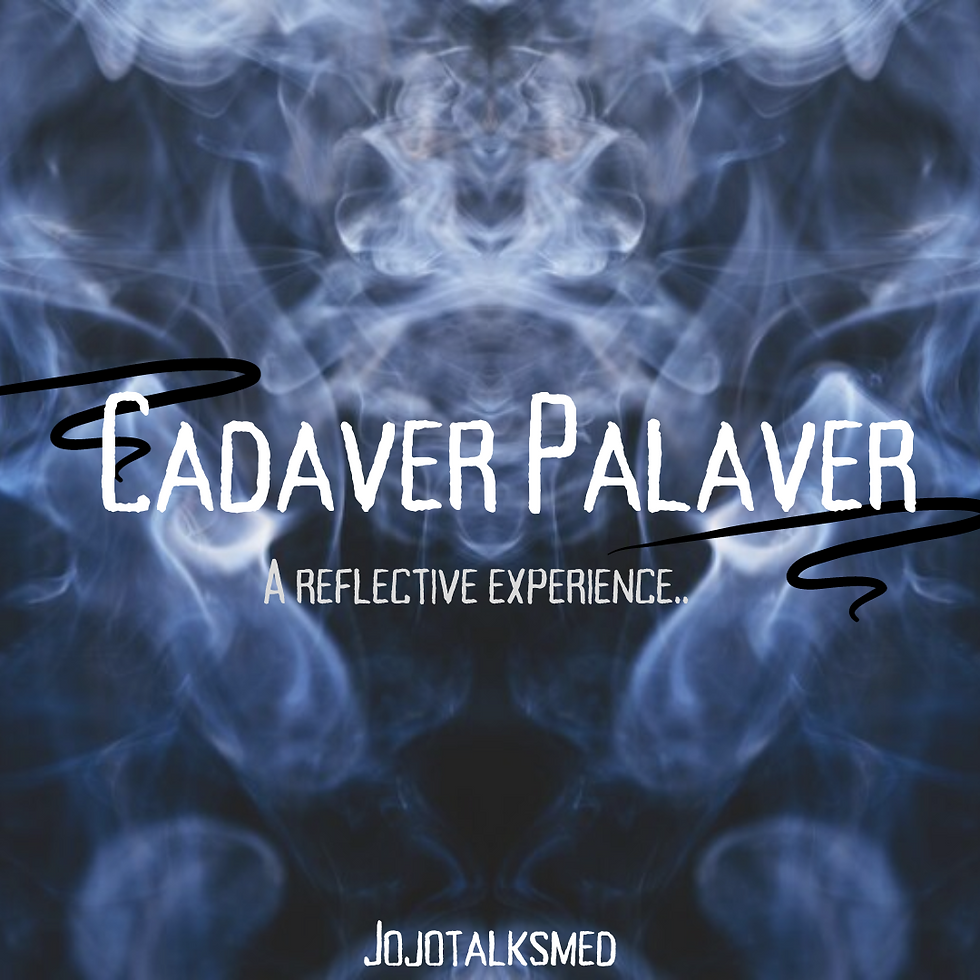Cadaver Palaver
- Jojo talks med

- Dec 3, 2023
- 3 min read

I should have known when I was perceiving the formalin even before entering the lab that something was wrong. The scene resembled an abattoir, but the inhumane kind, the stench forever etched in my olfactory senses and the one thought I had running laps in my mind was “I did not sign up for this!”. The truth is I did though, after all this is my promised land.
The lab had several tables with the lower limb of a human just like you and I on it, purely chaotic. My initial thoughts were this wasn’t exactly the picture I had in mind, it seemed like a horror movie but this is my line of work, I really just had to move forward to the cadaver for my laboratory group.
My emotional responses weren’t out of place, I felt really calm, or should I say, sober? Yes. I kept thinking this is the end result someday, hard reflections on the precarity of life and death and how I’m now training to be in a profession that hugely decides the fate of a human one way or the other. I had heavy and tough thoughts throughout the whole experience.
I do have to say the educational insights were there, I could understand the reason for such exposure, see those abstract bones and muscles whose names I had been cramming previously, view circulatory networks, fascia, you name it. It really showed me how visualization is an important approach in studying human medicine. As a professional, I have to be comfortable and conversant with these parts but I struggle to be immune to the circumstances that aid my learning this way.
This leaves me with a medical-ethical complexity where my ethical perspectives affect my considerations on how cadaver dissection is relevant to my medical training.
How do I navigate this complexity?

Board a thoughtful ride with me;
Cadaver dissection began in Ancient Egypt and Greece with older civilizations but didn’t gain prominence until the Renaissance period under the advocacy of Andrea Vesalius, a visionary of the 16th century and the advancement of medical illustrations, knowledge as well as surgical training due to this process till date cannot be undermined.
The broader interdisciplinary themes that connect to cadaver dissection succeeded in amazing me beginning from philosophical beliefs of ontology which is being - understanding the existence of life to forensic sciences, technological advancements, anthropology, even the stunning arts and literature we see revolving around the human body in form of anatomical works as well creative pieces.
Therefore, the insights gained from this practice not only advance medical knowledge and education but also have far-reaching implications for our understanding of life, death, and the human experience across different fields of study.
Even with these glaring benefits, the ethical complications are also quite concerning. Ethically, we’d consider respect for the deceased, proper treatment and the sanctity of the human body after death. There are also religious and cultural beliefs/sensitivities towards cadaver dissection sometimes pointedly declaring it a taboo. Body donation also remains a cause for ethical debate amongst professionals on whether it is just or utterly inhumane.
In conclusion, the historical significance of cadaver dissection in medical practice is immense, contributing significantly to medical knowledge and education as well as broader interdisciplinary themes. However, cultural attitudes toward death, the human body, and ethical considerations continue to shape perceptions of this practice in various societies.

What do you think at this point?
The ride is my way of bringing you facts and guiding you along as you consider whether this practice is acceptable or not. Let me know in the comments section!
For me, I’d say with this knowledge, I continue with the lasting impression that this is a practice very exclusive to the scientific world and it is very germane to my growth as a professional. However, I also realize that it may never stop making me feel sober and reflective, no matter how many times I put my gloves and nose mask on to do the work required of me.
On a happier note, happy new month to all my readers and happy one month of medical school to me, it’s been euphoric.
Thank you so much for reading, subscribe to this blog to get more medical content, give a like to express your pleasure with this post and comment to give your opinion.
Love, Jojo.










It goes without saying, sacrifices have to be made for the greater good, groundbreaking discoveries because somebody dared to do the unthinkable.
I believe this is human nature, creating rules to break them, having both good and terrible consequences.... The question is which rule is worth breaking, which rule will not leave you feeling mad at yourself at the end??
Watch Oppenheimer, there's a blurry, unclear line between right and wrong
"However, I also realize that it may never stop making me feel sober and reflective, no matter how many times I put my gloves and nose mask on to do the work required of me."
With you on this, JoJo!